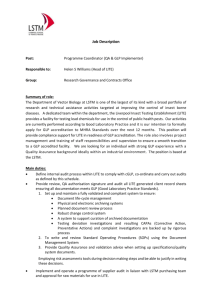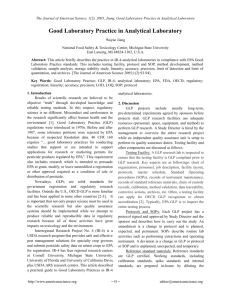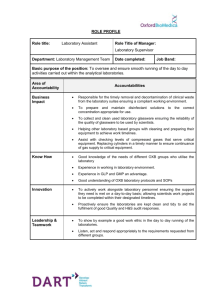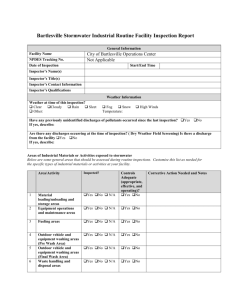Procedures and Conditions for GLP Registration
advertisement
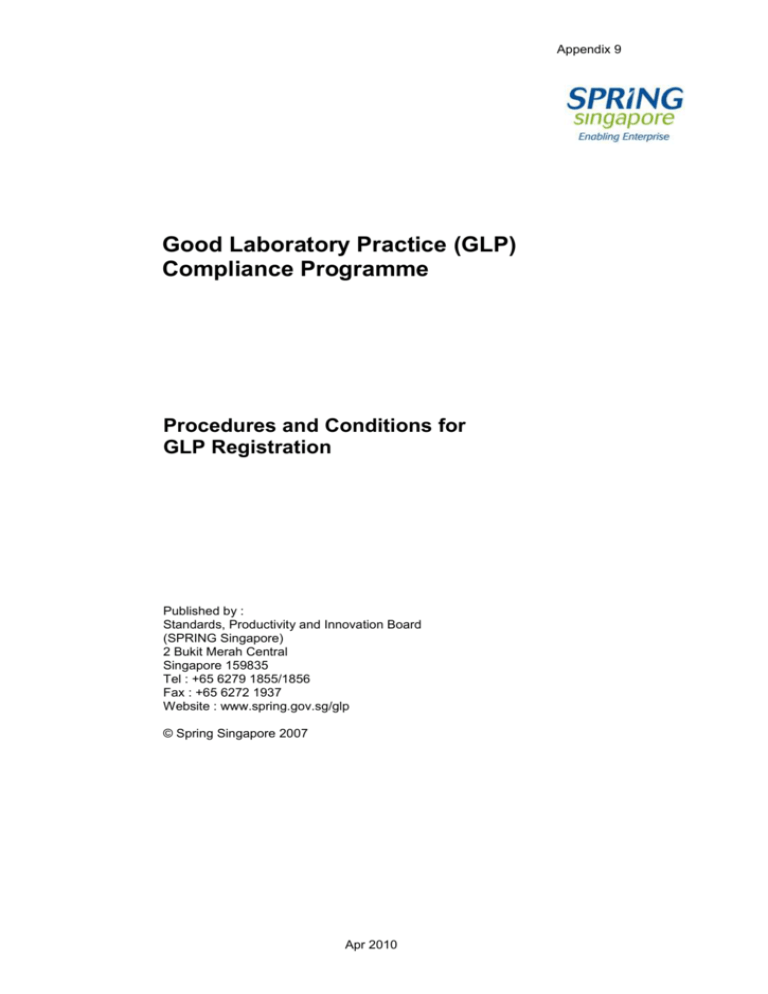
Appendix 9 Good Laboratory Practice (GLP) Compliance Programme Procedures and Conditions for GLP Registration Published by : Standards, Productivity and Innovation Board (SPRING Singapore) 2 Bukit Merah Central Singapore 159835 Tel : +65 6279 1855/1856 Fax : +65 6272 1937 Website : www.spring.gov.sg/glp © Spring Singapore 2007 Apr 2010 Appendix 9 CONTENTS Page Section A Registration Process 1 Introduction 3 2 Organisation Structure 3 3 Operational Standards 4 4 Registration Process 5 Scope 5 Application 6 Management Representative 7 Document Review 7 Inspection Process 7 Classification of Deficiencies 8 Scope of Registration 9 Surveillance Inspection Special Inspection Activities 9 10 Section B Rights and Duties of Applicant & Registered Facilities 5 Conditions for Registration 11 Duties of Applicant and Registered Facilities 11 Rights of Applicant and Registered Facilities 13 Confidentiality 14 6 Appeals and Complaints 14 Annex Registration Procedure Chart 17 Apr 2010 1. Introduction 1.1 Standards, Productivity and Innovation Board (SPRING Singapore) is the National Good Laboratory Practice Monitoring Authority. The mandate was issued by the Ministry of Trade and Industry (MTI) dated 20 November 2006. 1.2 For recognition of compliance with the OECD Principles of GLP, SPRING Singapore developed its GLP Compliance Programme in collaboration with the Agri-Food & Veterinary Authority (AVA), Economic Development Board (EDB), Health Sciences Authority (HSA) and National Environment Agency (NEA). The GLP Compliance Programme is available to any facility undertaking non-clinical health and environmental safety studies. The Programme will support studies that are required by local or overseas regulations for the purpose of registering or licensing for use of pharmaceuticals, pesticides, food & feed additives, cosmetics, veterinary drug products, industrial chemicals and similar products. SECTION A: REGISTRATION PROCEDURES 2. Organisation Structure 2.1 SPRING Singapore has been appointed by the Ministry of Trade and Industry as the national GLP Monitoring Authority (GLP MA) in November 2006. 2.2 As the GLP Monitoring Authority, SPRING Singapore will: a. administer the GLP Compliance Programme and register facilities that meet the OECD Principles of Good Laboratory Practice b. represent Singapore internationally in OECD committees and working groups c. work towards achieving the full membership of the OECD Mutual Acceptance of Data (MAD) in the assessment of chemicals 2.3 A GLP Advisory Committee comprising of various stakeholders such as regulator, industry association, tertiary and research institution, and GLP practitioner, has been set up to provide guidance on the operation of the Programme. 2.4 The Programme is managed under the Accreditation Division of SPRING Singapore. The GLP MA is responsible for the operation of the GLP programme and acts as the liaison with external organisations such as OECD, overseas regulators and overseas GLP counterparts. The GLP MA maintains a pool of inspectors who hold appropriate qualifications in various disciplines in science and technology, and are experienced in quality system operation and inspection. 2.5 The inspection of facilities is normally carried out by inspectors appointed by the GLP MA. Where required, technical experts may be appointed to the team to assist with the inspection of facility ’s compliance with the GLP criteria. Apr 2010 Page 3 of 17 Technical experts are chosen for their expert knowledge and experience, and they may be drawn from the government laboratories, academic and research institutions, and industrial organisations in Singapore and overseas. 3 Operational Standards 3.1 The GLP Compliance Programme is administered in accordance with the relevant requirements of ISO/IEC 17011: 2004 Conformity assessment – General requirements for accreditation bodies accrediting conformity assessment bodies and the following OECD Series of documents : 3.2 Number 2 : Guidance for GLP Monitoring Authorities – Revised Guidelines for Compliance Monitoring Procedures for Good Laboratory Practice ( Monograph no. 110 ) Number 3 : Guidance for GLP Monitoring Authorities – Revised Guidance for the Conduct of Laboratory Inspections and Study Audits ( Monographs 111) Number 9 : Guidance for GLP Monitoring Authorities – Guidance for the Preparation of GLP Inspection Reports ( Monograph No. 115 ) And any other documents published by OECD from time to time Testing facilities registered as being GLP compliant are assessed directly against the requirements of the following OECD Environmental Health and Safety Publications from the Series on Principles of Good Laboratory Practice and Compliance Monitoring: Number 1: The OECD Principles of Good Laboratory Practice (1998) Number 4: GLP Consensus Document: Quality Assurance and GLP (1999) Number 5: GLP Consensus Document: Compliance of Laboratory Suppliers with GLP Principles (1999) Number 6: GLP Consensus Document: The Application of the GLP Principles to Field Studies(1999) Number 7: GLP Consensus Document: The Application of the GLP Principles to Short-Term Studies (1999) Number 8: GLP Consensus Document: The Role and Responsibilities of the Study Director in GLP Studies (1999) Number 10: GLP Consensus Document: The Application of the Principles of GLP to Computerised Systems (1995). Number 13 : GLP Consensus Document : The Application of the OECD Principles to the Organisation and Management of Multisite Studies (2002) Number 14 : GLP Advisory Document : The Application of the Principles of GLP to In-vitro Studies (2004) Number 15 : GLP Advisory Document : The Establishment and Control of Archives that operate in compliance with the Principles of GLP (2007) And any other documents published by OECD from time to time. Apr 2010 Page 4 of 17 Document Number 1 is the primary criteria document against which all GLP compliant test facilities are inspected. These publications are available at no charge at the OECD’s World Wide Web site at: http://www.oecd.org/ehs Alternatively they can be obtained from: OECD Environment Directorate Environmental Health and Safety Division 2 rue Andre-Pascal 75775 Paris Cedex 16 France Fax: 33 1 4524 1675 4 Registration Process Scope 4.1 The Singapore GLP Compliance Programme is voluntary. Any facility that wishes to conduct studies, for submission on behalf of their sponsors, on environmental safety studies that are in compliant with the requirements of OECD Principles of Good Laboratory Practice may apply. A facility may also apply to the Programme on the request by a Receiving Authority either from Singapore or overseas. 4.2 Any facility interested to obtain registration as a GLP compliant facility is encouraged to study in detail the documents in clause 3.2. The facility is encouraged to have an ISO/IEC 17025 accreditation for the testing component associated with the GLP activities. This is, however, not mandatory. 4.3 The scope of application for the OECD Principles is restricted to non-clinical safety testing of test items contained in pharmaceutical products, pesticide products, cosmetic products, veterinary drugs, food additives, feed additives and industrial chemicals. The testing of these items is for the purpose of obtaining data on their properties and/or safety with respect to human health and/or the environment. 4.4 These non-clinical health and environment safety studies are intended to be submitted to regulatory or receiving authorities for the purpose of registering or licensing the pharmaceutical, pesticide, food or feed additive, cosmetic or veterinary drug product or for regulating the industrial chemical. 4.5 SPRING will grant a GLP compliance registration only for the types of studies and for the purposes indicated in clause 4.3. Other types of trials on test items (such as clinical trials) related to non-safety testing (eg efficacy) are outside the scope of the Programme. Apr 2010 Page 5 of 17 4.6 Once a test facility is satisfied that the OECD Principles of GLP are applicable to the scope of studies it conducts, and has documented its technical and quality systems to comply with the OECD Principles of Good Laboratory Practice and associated consensus documents, an application for registration can be made to SPRING. A schematic overview of the registration procedure is shown in flowchart in Annex 1. Preliminary Inspection 4.7 The facility may request for an advisory visit (prior to a formal initial inspection) by a SPRING Staff officer to review the existing systems and procedures. The objective of the visit is to advise on the readiness for the initial inspection and also on any aspects of the GLP quality system that need further development. A man-day charge is levied for such visit. Information on the various inspection fees can be found in the GLP Fee Schedule. Application 4.8 Application must be accompanied by the application fee as detailed in the GLP Fee Schedule. The application must include detailed background information of the facility as described in the application form. Some of the important information required in the form include : a. The type of non-clinical safety studies conducted at the facility for which GLP registration is sought. In accordance with OECD recommendations, these can be detailed under the following groupings : i. Physical- Chemical Testing ii. Toxicity Studies iii. Mutagenicity Studies iv. Environmental Toxicity Studies on Aquatic and Terrestrial Organisms v. Studies on Behaviour in Water, Soil and Air, Bioaccumulation vi. Residue Studies vii. Studies on the Effects of Mesocosms and Natural Ecosystems viii. Analytical and Clinical Chemistry Testing ix. Other Studies In addition, further detail on the scope of capability within these groupings for which the facility is seeking GLP compliance should be submitted to the Secretariat. b. Job Descriptions and curriculum vitae of key staff within the organisation such as CEO, Test Facility Management, Quality Assurance Personnel, Study Directors/ Principal Investigators, Pathologist, Veterinary Surgeon, Section Managers etc c. Organisation Charts Apr 2010 Page 6 of 17 4.9 d. Standard operating procedures (SOPs) providing the framework for the GLP quality system. e. Information on the physical facilities (including layout of facility, indications of clean and dirty areas, equipment listing etc) for which GLP compliance is sought, including any remote test sites f. A copy of the master schedule of studies. Once an application is received, a Lead Inspector will be appointed for the facility. This Inspector will review the SOPs against the OECD Principles of Good Laboratory Practice to confirm the readiness for an initial inspection. A document review report will be issued to the facility identifying any gaps so that the facility can rectify the discrepancies. A suitable date will be arranged for the on-site inspection. Management Representative 4.10 Each applicant and registered facility is required to nominate a senior staff member to represent it in all dealings with SPRING. This person will be the point of contact between SPRING and the facility and is known as the Management Representative. All correspondences and invoices will be addressed to the Management Representative. 4.11 The Management Representative may be a senior technical or managerial staff or a Quality Assurance personnel who holds an appropriate position in the organisation with the authority to ensure their facility complies with the criteria for registration at all times. The facility is obliged to inform SPRING immediately whenever there is a change of responsibilities or resignation of the Management Representative. The Management Representative is expected to be present at entry and exit meetings for the GLP inspection. Documentation Review 4.12 Before initial inspection and routine inspection of the facility, the facility’s SOPs and supporting documents making up the framework of the GLP system will be reviewed to ensure compliance with the OECD Principles of Good Laboratory Practice and applicable consensus and advisory documents. Inspection Procedure 4.13 The facility should approach a GLP inspection as an opportunity for professional, technical and quality management information exchange. The inspection is not to find fault, but rather to evaluate the system and to provide helpful, constructive comment and suggestions to enable the facility to maintain an effective GLP system. 4.14 The inspection is a fact-finding exercise undertaken by SPRING staff, and where necessary, by one or more technical experts. Where technical experts Apr 2010 Page 7 of 17 are appointed, they are acting on behalf of SPRING for the GLP Programme and do not represent any other organisation with which they may be associated. 4.15 The facility has a right to veto once the use of any particular inspector or technical expert proposed for the inspection provided there are valid reasons such as conflict of interest. 4.16 The objective of inspection is to confirm that the facility is implementing what it has documented in its SOPs and that its system is in accordance with the OECD Principles of Good Laboratory Practice. For an inspection to take place, the prospective facility shall have completed at least one study that has been conducted in compliance with the Principles. During the on-site visit, the inspector(s) will focus on the operation of the GLP system. Information gathered will include, but is not limited to, review of records, discussions with management and key GLP personnel, and observation of relevant activities. A significant element of the inspection will involve study audits - of studies in progress and/or completed studies from the archive. 4.17 The time to conduct an on-site inspection will depend on the size of the facility, the number of test sites and the scope of registration. It may range from 1 to 5 days. 4.18 The on-site inspection starts with an entry meeting between the SPRING inspector(s) and senior / key staff of the facility. The entry meeting provides an opportunity for: introductions between the key GLP personnel and the inspection team confirmation of the scope of inspection (considering both studies conducted and test sites) and the timetable for inspection Clarification of any queries that the inspector(s) or staff may have. 4.19 The facility will be asked to provide appropriate guide(s)/ escort(s) for each phase of the inspection. These escorts should be senior staff of the organisation who has sufficient authority to ensure the inspector(s) have access to all documents, personnel and activities they may wish to see. Classification of Deficiencies 4.20 Observations made during the inspection will be recorded on a checklist. These will include observations of compliance as well as any deficiencies. 4.21 Following the information gathering, the inspector(s) will meet in private to review their notes and summarise their findings. 4.22 The on-site inspection will end with an exit meeting where the facility representatives are given a summary report including any deficiencies that have been found. All findings will be fully discussed with the facility representatives before the departure of the team. Apr 2010 Page 8 of 17 4.23 Within seven working days of the visit, a written report on the inspection findings will be sent to the facility. The findings will be placed into two categories: Major – a deficiency that has led or may lead (if not addressed immediately) a facility or system to be out of compliance. A response on corrective actions taken is required with supporting evidence. The response time for corrective actions of “major” deficiencies is dependent on the severity of the deficiencies. For serious major deficiencies, the facility may face an immediate suspension or a withdrawal of registration. Examples of serious major deficiencies are breakdown in the facility’s GLP compliance or fraudulent practices in data recording. Facility is typically given one month for corrective actions. The Lead Inspector has the discretion where appropriate to shorten the response time to two weeks or less. If necessary, a verification visit or non routine inspection may be conducted to confirm GLP compliance. Minor - for a departure from the Principles which is not considered as a major deficiency. This may be a recommendation or a reminder for follow up review at the next inspection. 4.24 The test facility will be informed at the Exit Meeting of the possible outcomes. These outcomes may be: a. In Compliance with GLP - No major deficiency are identified and registration will be granted/continued following satisfactory provision of documented objective evidences for any other minor deficiencies (if any). b. Pending (may apply to applicant facility) – A partial compliance with GLP is found with some major deficiencies noted. These deficiencies do not affect the validity of the studies, however clearance of these deficiencies is required. An on-site inspection by a SPRING staff may be conducted to verify for effective implementation. The charges for such follow-up visit are based on the rate in the GLP Fee Schedule. c. Not in Compliance with GLP - The test facility is unable to meet the Principles of Good Laboratory Practice and a full reinspection is required be conducted after it has addressed the deficiencies. 4.25 The lead inspector will monitor the progress of the test facility in carrying out the required corrective actions. Once satisfied that all conditions for registration have been met, a recommendation for registration will be made. A Certificate of Registration will be issued to the applicant facility. In addition, the name of the test facility together with details of its scope of GLP compliance will be posted in the SPRING website for the Programme. Apr 2010 Page 9 of 17 4.26 For an existing registered facility, an inspection team may find some deficiencies from time to time (in study audits or GLP compliance of the facility) that are classified as “major”. If the on site evidence show that there is a breakdown in GLP compliance of the facility, the inspectors will recommend an immediate suspension or withdrawal of registration. If findings show that some of the “major” classification of the findings may lead a facility or a system to be out of compliance, the lead inspector has the discretion to shorten the corrective action response time to a shorter period. Scope of Registration 4.27 In addition to the Certificate of Registration, a Schedule will be issued, which detailed the scope or types of non-clinical safety studies for which GLP compliance can be claimed under the Programme. 4.28 This scope will be presented under the classification detailed in clause 4.8 above, but will include further details to describe the types of studies that the facility is properly equipped and sufficiently experienced to conduct. Surveillance Inspection 4.29 Once the test facility is registered, it will be subjected to surveillance inspection. The surveillance programme is designed to ensure that the GLP systems continues to meet the criteria for registration and continues to work effectively. SPRING reserves the right, however, to undertake additional inspection at any time to investigate complaints of any nature. 4.30 At the first anniversary of the initial on-site inspection, a routine study audit will be conducted on-site by an inspector(s). In order to ensure that the GLP systems are operating effectively, SPRING considers a routine study audit as necessary. The scope of a routine study audit is normally to follow up on the findings of the initial inspection and to conduct one or more study audits on completed studies from the archive or studies in progress. Some other elements of the GLP system may be examined at these visits, particularly if there are changes in personnel or in other key areas. 4.31 At the second anniversary of the initial on-site inspection, and every two years thereafter, a full inspection will be carried out. The full inspections are similar in scope, duration and procedures to the initial inspection. Surveillance inspections will be carried at every alternate year between the full inspections. 4.32 For both the routine study audit and full inspections, the reporting procedures are similar to those at initial inspections. Once the facility is registered, there is a limit on the time required to carry out any corrective actions. Once compliance has been demonstrated within the agreed time, SPRING will continue registration of the facility. 4.33 A registered facility can submit a written request for a change in the scope of registration to the SPRING at any time. If the request to extend the range or types of studies that the facility can undertake does not coincide with the Apr 2010 Page 10 of 17 scheduled inspection visit, SPRING will have to carry out a special inspection to confirm compliance with the OECD Principles for these types of studies. Such an inspection will be chargeable. 4.34 If the routine study audits, full inspections or any special inspections conducted reveal that the test facility’s systems no longer meet SPRING’s criteria for registration or the GLP Principles, or if the organisation refuses to carry out requested corrective actions either at all, or in the specified time, then registration may be suspended or withdrawn. Special Inspection Activities 4.35 In addition to the circumstance indicated in clause 4.33 where the test facility can request a special inspection at any time to consider an extension to its scope of registration, the following are other circumstances that may require additional special inspections : a. The facility has had a physical change in accommodation that necessitates an on-site inspection to verify registration criteria are being maintained. b. Information is bought to SPRING’s attention which strongly suggests the registered facility is no longer operating in compliance with the GLP Principles. c. Following a formal request from a regulatory or receiving authority either in Singapore or from another OECD country. Such requests to SPRING would normally arise from a particular study conducted or to be conducted at the facility, and which are intended to or have been submitted to the requesting authority. The scope of such inspection would likely be restricted to an audit of the particular study in question. d. SPRING has been requested to conduct an inspection of a particular test facility or test site by another GLP compliance monitoring authority. This would normally apply to multi-site studies where the main test facility is overseas, with a particular test site in Singapore SECTION B: RIGHTS AND DUTIES OF APPLICANT & REGISTERED FACILITIES 5 Conditions for Registration 5.1 Duties of Applicant and Registered Facilities 5.1.1 The facility must have a written quality management system that states how the facility meets all of the requirements of the OECD Principles of Good Laboratory Practice, applicable consensus and advisory documents and applicable registration criteria. The quality system of the facility must operate in the way it is documented. Apr 2010 Page 11 of 17 5.1.2 The facility must allow inspector(s) and observers reasonable access to the premises, facilities, resources, operations, procedures, records and staff so that the inspector(s) can effectively assess the GLP systems and activities. 5.1.3 The facility must agree to allow inspector(s) the right to take samples, inspect records and to produce copies and photographs on site, if it is necessary for reasons of perpetuation of evidence. 5.1.4 The facility must promptly pay all fees, charges and expenses relating to the initial inspection, registration of facility and any subsequent activities by SPRING regardless of the outcome of these activities. Failure to do so may result in the suspension or withdrawal of the registration, and a requirement for any future fees to be paid in advance. The prevailing rates are detailed in the GLP Fee Schedule. SPRING reserves the right to change the fees as and when necessary. 5.1.5 The facility must maintain impartiality and integrity in its dealings with clients and all interested parties involved in the registered activity. 5.1.6 The facility may claim to be a registered GLP compliant facility (or make reference to the registration in any advertising or communication medium) only for work covered by the scope of study types which the facility have been registered by SPRING and only if that work has been carried out in accordance with the SPRING criteria. The facility must not make any statement about its registration that SPRING considers misleading or which is not authorised. The facility must not use the registration in such a way as to bring SPRING into disrepute. 5.1.7 The facility must not use the registration to imply approval by SPRING of any product or item the facility has tested. 5.1.8 The facility must ensure that the study reports are issued (or parts of them) are not used in a way that could mislead sponsors or others. 5.1.9 The facility must notify SPRING promptly of changes in the facility’s status or operations such as: loss of key GLP personnel, particularly the GLP management changes in senior personnel duties and responsibilities (including change of Management Representative) significant changes in accommodation and/or equipment changes in legal, commercial or organisational status changes in policies and procedures. 5.1.10 The facility must not vary the technical operations or facilities covered in the scope of registration during the period between inspections, unless notice has been given in writing and a confirmation in writing have been made that such changes do not invalid a registration. 5.1.11 The reference to GLP compliant study in any study final report shall adhere Apr 2010 Page 12 of 17 strictly to the terms stated in clause 5.1.1. 5.1.12 The registration may be withdrawn either by the facility or by SPRING. The facility must immediately stop making reference to terms “GLP (compliant) facility/laboratory”, “Registered facility/laboratory” or the like, and all advertising materials which contains the terms or refers to them. The Certificates of Registration and Schedules must be returned to SPRING or destroyed. 5.1.13 If the facility is temporarily unable to meet the registration conditions, SPRING may request the facility to stop making any reference to SPRING registration. The facility may also be asked not to claim compliance with the criteria for registration until SPRING is satisfied that the facility is meeting the conditions, or pending the result of any appeal made by the facility. If the facility fails to comply with such a request, SPRING may: suspend registration, or withdraw registration, or decline to continue or extend the scope of registration, or reduce the scope of registration. Such decisions and the grounds for them will be communicated to the facility in writing. The facility’s compliance with these decisions will be reviewed at a non routine inspection. 5.1.14 SPRING may withdraw or decline to grant or continue registration if the facility becomes bankrupt or makes any arrangements with its creditors, or enters into liquidation, whether compulsory or voluntary (but not including liquidation for the purpose of reconstruction), or has a receiver appointed, or is sold or is taken over. Such decisions and the grounds for them will be communicated to the facility in writing. In addition, SPRING may require the facility to stop displaying the registration certificate during this period and to refrain from any reference to itself as registered under the GLP Compliance Programme. 5.1.15 The facility whose registration that has been terminated may re-apply after one year from the anniversary date as stated on the letter of termination. The registration process follows clause 4.12 of this document. 5.2 Rights of Applicant and Registered Facilities 5.2.1 Application under the GLP Compliance Programme is open to all organisations that come within the scope detailed in Clause 4.8 above, regardless of size or professional affiliations. 5.2.2 SPRING will confine its requirements, inspections and registration decisions to the scope of registration requested. 5.2.3 The application will normally be acknowledged within 1 working day of receipt Apr 2010 Page 13 of 17 and a tax invoice for the application fee paid will be provided. 5.2.4 An estimate of time required, fees and expenses (where relevant) for inspection activity will be provided. 5.2.5 A report with the results of each inspection will be sent to the facility within 7 working days from the completion of the on-site inspection. 5.2.6 Upon the granting of registration, SPRING will issue facility with a Certificate of Registration and will include registration details of the facility in the website. 5.2.7 SPRING will notify the facility of any changes in the criteria for registration and give the facility reasonable time to adjust its procedures to meet the new requirements. 5.2.8 Registration is continued in the second year following the granting of registration, and every two years thereafter, subject to the facility in meeting the requirements. 5.2.9 A facility has the right to veto any proposed inspector or technical expert whom the facility considers may have a conflict of interest when conducting the inspection. 5.2.10 Complaints or appeals can be made to SPRING Singapore. 5.2.11 The facility must allow inspector(s) and observers reasonable access to the premises, facilities, resources, operations, procedures, records and staff so that the inspector(s) can effectively assess the GLP systems and activities. 5.3 Confidentiality 5.3.1 SPRING requires its inspectors, staff and technical experts to abide by a code of ethics, professional standards and confidentiality. They agree in writing to keep information about the facility confidential and to declare any conflicts of interest. 5.3.2 All inspectors, observers ( such as members of Mutual Joint Visit teams from OECD), committee members and members of SPRING Staff sign undertakings of confidentiality and independence. For inspectors and technical experts, an additional undertaking has to be signed prior to the initial appointment as inspectors. 5.3.3 All applications will be treated as confidential until the facility is registered. 5.3.4 As part of Singapore’s adherence to the OECD Council Acts, SPRING has an obligation to inform OECD GLP Working Group of registered facilities. Similarly, should there be any suspension or withdrawal of non-GLP compliant studies, such information will also be provided. The information provided may include the name of the facility and study, the name of the sponsor, study dates, etc. These information may be passed to the Receiving Authorities of Apr 2010 Page 14 of 17 the Working Group member countries. Facilities by applying to be part of SPRING’s GLP programme waive the confidentiality of this information to SPRING and allows SPRING to release the information. Facilities will be asked to re-submit the application form prior to the re-inspection every two years as an agreement for this waiver. 5.3.5 SPRING may be asked to submit reports of inspections or study audits to regulatory authorities. In addition, compliance statements or summaries of biennial inspections or reports of study audits may be made by SPRING to the requesting authority. SPRING Singapore would evaluate such request and if it has been determined that there is a need, the request would be acceded. In such cases, the facility’s consent for the issuance of the inspection report to external authorities would be sought. 6. Appeals and Complaints 6.1 Appeals and complaints fall into three categories: appeals on registration decisions complaints on registered facilities complaints on registration and inspection activities. 6.2 Appeals and complaints should be sent to SPRING in writing. Appeals on Registration Decisions 6.3 An appeal may be made about a registration activity, such as: suspension of registration or part of the registration scope withdrawal of registration. 6.4 For disagreements related to inspector procedure, decision or activities, the facility should attempt to resolve any technical appeals with the Lead Inspector or the Head (GLP) of SPRING Singapore. 6.5 For formal appeal on registration decisions, it should be made in writing and should be send to the Director of Accreditation, SPRING Singapore. An appropriate person will be appointed by the Director to investigate it. The Director, in consultation with the Group Director of Quality & Standards and Chair of GLP Advisory Committee will appoint an independent appeal committee to look into the appeal. The appeal will consider whether: current SPRING policies and procedures have been properly followed current SPRING policies and procedures are adequate and appropriate registration decisions have been soundly based on objective evidence. 6.6 A Committee for Appeals (CFA) is set up as and when there is an appeal to be heard. The CFA will comprise of 3 members from the Advisory Committee. External experts may be co-opted where required. SPRING will undertake due Apr 2010 Page 15 of 17 diligence to ensure all CFA members are independent and have no conflict of interest with the appellant. No facility representation is involved in any appeal. 6.7 The decision of the appeal and the proposed actions if any, will be sent to the facility. 6.4 Complaints on Registered Facilities 6.4.1 Registered facilities are responsible for the quality of their own services. They should deal appropriately through their own complaint procedures for complaints from customers or public. 6.4.2 When a formal complaint about a registered facility is received, the Director of Accreditation Division will appoint an appropriate person to investigate it. If the complaint is not relating to the compliance to GLP Principles, SPRING will facilitate the complainant and the registered facility to negotiate a satisfactory outcome. However if the complaint relates to the compliance of the facility to the GLP Principles, SPRING will investigate the legitimacy of the complaint and conduct an on-site inspection, if required. 6.4.3 The results of SPRING investigations, and the proposed actions if any, will be feedback to the registered facility and to the complainant accordingly. 6.5 Complaints on Registration Activities 6.5.1 Any complaints about the performance of SPRING services or of staff or inspectors will be investigated by the Head (GLP) or an appropriate person appointed by the Director of Accreditation Division using the formal SPRING complaints procedure. The facility will be advised of the result of the investigation and of corrective action taken. Apr 2010 Page 16 of 17 Annex 1 Registration Procedure Chart Initial Client Contact Formal Application Preliminary Inspection (Optional) Documentation review OK? No Correct System Yes On-site initial Inspection Yes OK? No Major Findings? Yes No Review of Recommendation Clear CARs Registration of Compliance granted 1 Year Surveillance Inspection Yes OK? No Pending till deficiencies rectified Major? No Yes Review of Recommendation Clear CARs Registration of Compliance Confirmed 1 year Documentation review Full inspection Yes OK? No Major? No Secretariat review Pending till deficiencies rectified Clear CARs Registration of Compliance Confirmed Apr 2010 Page 17 of 17

